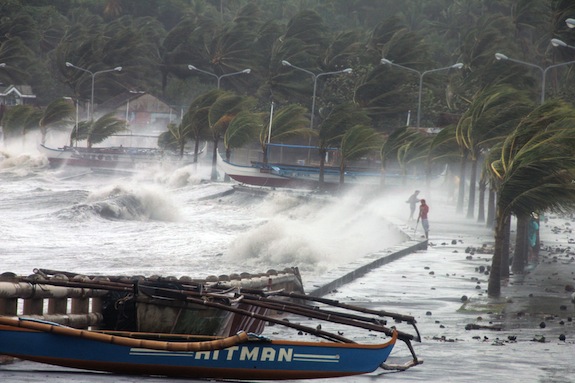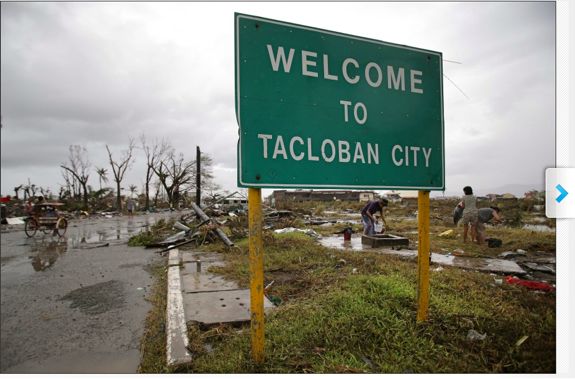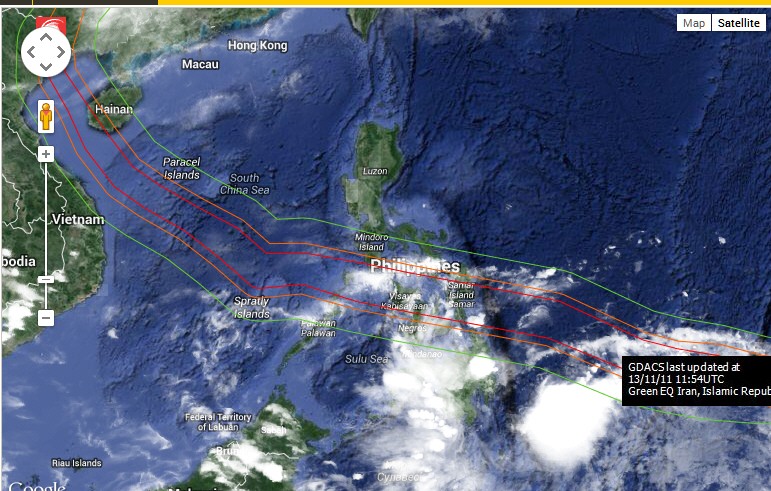
ESTIMATED OVER 10,000 PEOPLE KILLED
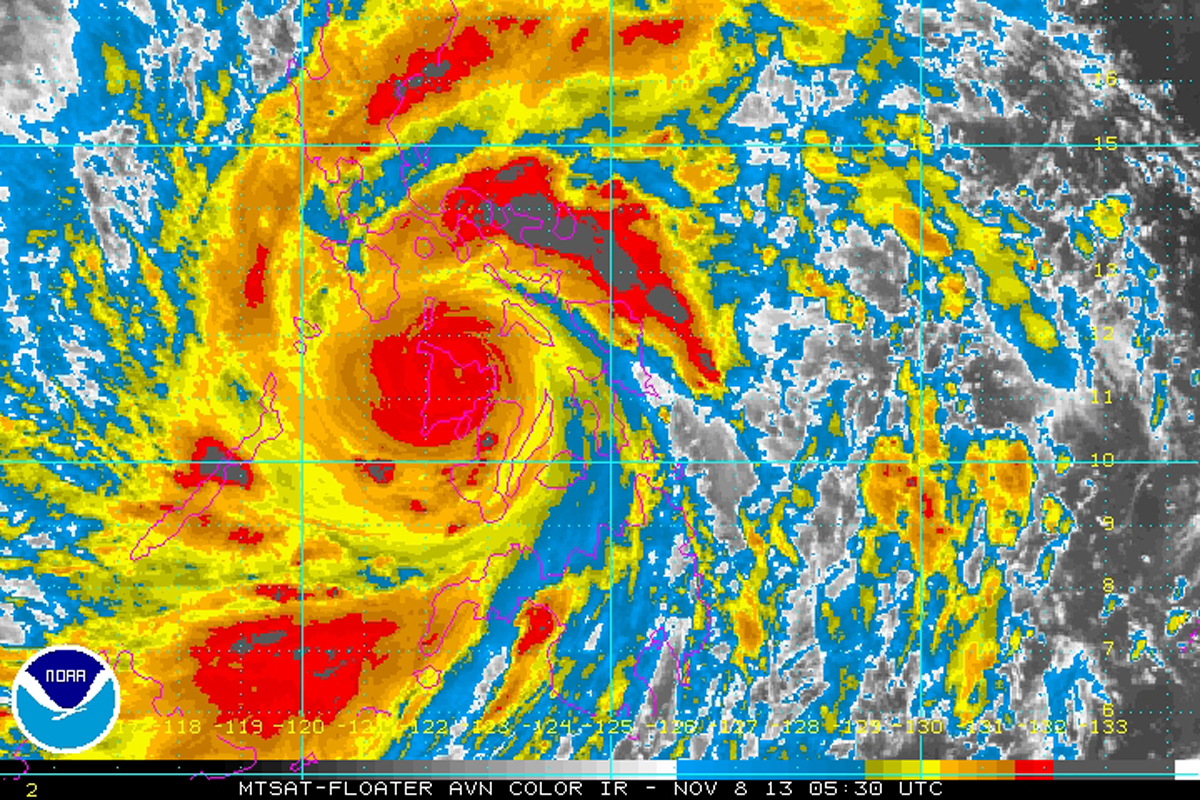
Dee Finney's blog
start date July 20, 2011
today's date November 11, 2013
page 593
WORST STORM IN RECORDED HISTORY
Philippines Typhoon Death Toll Rises In Storm's Aftermath
11-15-2013
Body bags are lined up along the street curbs.
MANILA, Philippines (AP) — A top Philippine civil defense official says the
death toll from last week's Typhoon Haiyan has risen to 3,621.
That's a jump of more than 1,200 from the previous toll of 2,360 that was
announced earlier Friday by the National Disaster Risk Reduction and Management
Council.
Its executive director, Eduardo del Rosario, told reporters that the "latest
death toll" from all the provinces hit by the typhoon is 3,621. He did not give
details. An official at the agency later said its website will be updated with
the latest toll later Friday.
The new figure has surpassed the estimated 2,500 deaths that President Benigno
Aquino III had predicted earlier this week
Typhoon Haiyan: Death Toll From Storm Tops 3,600 In The Philippines
Full horror of destruction in Philippines revealed as rescue workers says
two thirds of dead are children
- Typhoon Haiyan was a maximum
category-five storm with gusts of up to 235mph
- Authorities say in the city of
Tacloban, Leyte, alone, 10,000 could be dead
- Up to 4.3 million people have been
affected, Filipino national disaster agency say
- Bodies were seen floating in flooded
streets in reminder of 2004 Tsunami
- Filipino government now considering
introducing martial law to combat looting
- Britain has pledged more than
£6million in aid and support for the Philippines
- UN says 2.5m people need of food aid
and UNICEF estimate 1.5 m children affected
- A team of about 90 US Marines and
sailors have been dispatched to the nation
- Hundreds of thousands of people in
South-East Asia have been evacuated
- Vietnam authorities have moved 883,000
people in 11 central provinces to safe zones
- Typhoon has now made landfall in Sanya
in south China's Hainan province
By
Becky Evans,
Richard Shears and
Sophie Jane Evans
PUBLISHED: 10:33 GMT, 11
November 2013 | UPDATED:
14:46 GMT, 11 November 2013
A survivor of the devastating Philippines
typhoon has described the grim scenes in the city of Tacloban saying 'Two out of
every five corpses I saw were kids.'
Lynette Lim, the Asia communications
manager for Save the Children said: 'The water was knee high and there were
bodies floating in the streets. I saw several dead children.'
In the worst-hit areas, 235mph winds
created 20ft waves that are thought to have killed between 10,000 and 15,000 and
left 500,000 homeless after their houses were reduced to splinters.
Super-typhoon Haiyan struck with such force
on Friday that entire villages were flattened, ships were swept inland and
corpses were left hanging from trees.
Desperate survivors of the devastating
Philippines typhoon told how they had to steal from the dead to eat.
View Video and Pictures and Read More At:
http://www.dailymail.co.uk/news/article-2499851/Typhoon-smashed-houses-smithereens-Full-horror-destruction-Philippines-revealed-rescue-workers-says-thirds-dead-children.html
Associated Press
TACLOBAN, Philippines -- TACLOBAN, Philippines (AP) -- As many as 10,000 people
are believed to have died in one Philippine city alone when one of the worst
storms on record sent giant sea waves, washing away homes, schools and airport
buildings, officials said Sunday. Ferocious winds ravaged several central
islands, burying people under tons of debris and leaving corpses hanging from
trees.
Regional police chief Elmer Soria said he was briefed by Leyte provincial Gov.
Dominic Petilla late Saturday and told there were about 10,000 deaths in the
province, mostly by drowning and from collapsed buildings. The governor's figure
was based on reports from village officials in areas where Typhoon Haiyan
slammed Friday.
Tacloban city administrator Tecson Lim said that the death toll in the city
alone "could go up to 10,000." Tacloban is the Leyte provincial capital of
200,000 people and the biggest city on Leyte Island.
On Samar Island, which is facing Tacloban, Leo Dacaynos of the provincial
disaster office said Sunday that 300 people were confirmed dead in Basey town
and another 2,000 are missing.
He said that the storm surge caused sea waters to rise 6 meters (20 feet) when
Typhoon Haiyan hit Friday, before crossing to Tacloban.
There are still other towns on Samar that have not been reached, he said, and
appealed for food and water. Power was knocked out and there was no cellphone
signal, making communication possible only by radio.
Reports from the other four islands were still coming in, so far with dozens of
fatalities.
The typhoon barreled through six central Philippine islands on Friday, wiping
away buildings and leveling seaside homes with ferocious winds of 235 kilometers
per hour (147 miles per hour) and gusts of 275 kph (170 mph). By those
measurements, Haiyan would be comparable to a strong Category 4 hurricane in the
U.S., and nearly in the top category, a 5.
It weakened Sunday to 166 kph (103 mph) with stronger gusts and was forecast to
loose strength further when it hits northern Vietnam's Thanh Hoa province early
Monday morning.
In hardest-hit Tacloban, about 300-400 bodies have already been recovered but
there are "still a lot under the debris," Lim said. A mass burial was planned
Sunday in Palo town near Tacloban.
Many corpses hung on tree branches, buildings and sidewalks.
"On the way to the airport we saw many bodies along the street," said
Philippine-born Australian Mila Ward, 53, who was waiting at the Tacloban
airport to catch a military flight back to Manila.
"They were covered with just anything -- tarpaulin, roofing sheets, cardboards,"
she said. Asked how many, she said, "Well over 100 where we passed."
Interior Secretary Mar Roxas said a massive rescue operation was underway. "We
expect a very high number of fatalities as well as injured," Roxas said after
visiting Tacloban on Saturday. "All systems, all vestiges of modern living --
communications, power, water -- all are down. Media is down, so there is no way
to communicate with the people in a mass sort of way."
President Benigno Aquino III, who landed in Tacloban on Sunday to get a
firsthand look at the disaster, said the casualties "will be substantially more"
than the official count of 151 -- but gave no figure or estimate. He said the
government's priority was to restore power and communications in isolated areas
to allow for the delivery of relief and medical assistance to victims.
The Philippines has no resources on its own to deal with a disaster of this
magnitude, and the U.S. and other governments and agencies were mounting a major
relief effort, said Philippine Red Cross chairman Richard Gordon.
At the request of the Philippine government, Defense Secretary Chuck Hagel
directed U.S. Pacific Command to deploy ships and aircraft to support
search-and-rescue operations and airlift emergency supplies, according to a
statement released by the Defense Department press office.
The president of the European Commission, Jose Manuel Barroso, said in a message
to Aquino that the EC had sent a team to assist the Philippine authorities and
that "we stand ready to contribute with urgent relief and assistance if so
required in this hour of need."
Even by the standards of the Philippines, which is buffeted by many natural
calamities -- about 20 typhoons a year, earthquakes and volcanic eruptions --
the latest disaster shocked the impoverished nation of 96 million people.
If the typhoon death toll is confirmed, it would be the deadliest natural
catastrophe on record in the Philippines. The deadliest typhoon before Haiyan
was Tropical Storm Thelma in November 1991, which killed around 5,100 people in
the central Philippines. The deadliest disaster so far was the 1976
magnitude-7.9 earthquake that triggered a tsunami in the Moro Gulf in the
southern Philippines, killing 5,791 people.
The airport in Tacloban, about 580 kilometers (360 miles) southeast of Manila,
looked like a muddy wasteland of debris, with crumpled tin roofs and upturned
cars. The airport tower's glass windows were shattered, and air force
helicopters were busy flying in and out at the start of relief operations.
Residential homes that had lined up a 7-kilometer (4-mile) stretch of road
leading to Tacloban city were all blown or washed away.
The winds were so strong that Tacloban residents who sought shelter at a local
school tied down the roof of the building but it was still ripped off and the
school collapsed, Lim said. It wasn't clear how many died there.
"The devastation is, I don't have the words for it," Roxas said. "It's really
horrific. It's a great human tragedy."
Defense Secretary Voltaire Gazmin said Aquino was "speechless" when he told him
of the devastation the typhoon had wrought in Tacloban.
"I told him all systems are down," Gazmin said. "There is no power, no water,
nothing. People are desperate. They're looting."
The city's two largest malls and groceries were looted and the gasoline stations
destroyed by the typhoon. Police were deployed to guard a fuel depot to prevent
looting of fuel.
On Sunday, the city's overwhelmed services were reinforced by 100 special police
force units sent in from elsewhere to help restore peace and order.
Tacloban is near the Red Beach on Leyte Island where U.S. Gen. Douglas MacArthur
waded ashore on October 20, 1944, fulfilling his famous pledge, "I shall
return," made in March 1942 after President Franklin D. Roosevelt ordered him to
relocate to Australia as Japanese forces pushed back U.S. and Filipino
defenders.
Tacloban was the first city to be liberated by U.S. and Filipino forces and
served as the Philippines' temporary capital for several months. It is also the
home town of former Filipino first lady Imelda Marcos, whose nephew, Alfred
Romualdez, is the city's mayor.
One Tacloban resident said he and others took refuge inside a parked Jeep to
protect themselves from the storm, but the vehicle was swept away by a surging
wall of water.
"The water was as high as a coconut tree," said 44-year-old Sandy Torotoro, a
bicycle taxi driver who lives near the airport with his wife and 8-year-old
daughter. "I got out of the Jeep and I was swept away by the rampaging water
with logs, trees and our house, which was ripped off from its mooring."
"When we were being swept by the water, many people were floating and raising
their hands and yelling for help. But what can we do? We also needed to be
helped," Torotoro said.
In Torotoro's village, bodies could be seen lying along the muddy main road, as
residents who had lost their homes huddled, holding on to the few things they
had managed to save. The road was lined with trees that had fallen to the
ground.
Vice Mayor Jim Pe of Coron town on Busuanga, the last island battered by the
typhoon before it blew away to the South China Sea, said most of the houses and
buildings there had been destroyed or damaged. Five people drowned in the storm
surge and three others were missing, he said by phone.
"It was like a 747 flying just above my roof," he said, describing the sound of
the winds. He said his family and some of his neighbors whose houses were
destroyed took shelter in his basement.
In the aftermath of the typhoon, people were seen weeping while retrieving
bodies of loved ones inside buildings and on a street that was littered with
fallen trees, roofing material and other building parts torn off in the storm's
fury. All that was left of one large building whose walls were smashed in were
the skeletal remains of its rafters.
Tim Ticar, a local tourism officer, said 6,000 foreign and local tourists were
stranded on the popular resort island of Boracay, one of the tourist spots in
the typhoon's path.
U.N. Secretary-General Ban Ki-moon offered his condolences and said U.N.
humanitarian agencies were working closely with the Philippine government to
respond rapidly with emergency assistance, according to a statement released by
the U.N. spokesperson's office.
UNICEF estimated that about 1.7 million children are living in areas impacted by
the typhoon, according to the agency's representative in the Philippines Tomoo
Hozumi. UNICEF's supply division in Copenhagen was loading 60 metric tons of
relief supplies for an emergency airlift expected to arrive in the Philippines
on Tuesday.
In Vietnam, preparations for the typhoon were underway. About 600,000 people
from the central region who had been evacuated returned home because the storm
changed course and was instead heading for the northern coast, where authorities
began evacuating nearly 100,000 in three northern provinces.
___
Associated Press writers Oliver Teves and Teresa Cerojano in Manila, and Minh
Tran in Hanoi, Vietnam, contributed to this report.
More from HuffPost:
Residents devastated by the storm are in dire need of help.
Magina Fernandez told
CNN, "Get international help to
come here now -- not tomorrow, now. This is really, really like bad, bad, worse
than hell, worse than hell."
To find out how you can help, click
here.
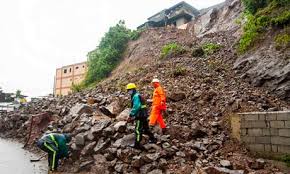
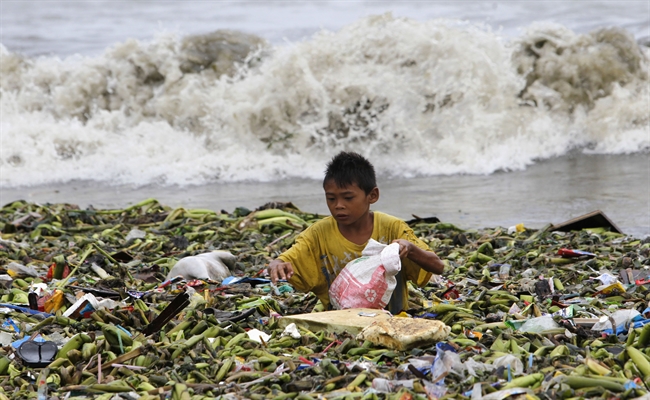
A boy sifts through floating garbage as he collects recyclable items to sell
while strong waves crash along the shores of Manila Bay, near a slum area in
Manila, 2013. Tge Typhoon slammed into the Philippines, weakening slightly
after hitting the country’s north and is moving slowly west-northwest, weather
and disaster officials said. (Reuters) It's now headed for Vietnam.
President Benigno Aquino III warned people to leave high-risk areas, including
100 coastal communities where forecasters said the storm surge could reach up to
7 meters (23 feet).
Aquino ordered officials to aim for zero casualties, a goal often not met in an
archipelago lashed by about 20 tropical storms each year, most of them deadly
and destructive. Haiyan is the 24th such storm to hit the Philippines this year.
The president also assured the public of war-like preparations: three C-130 air
force cargo planes and 32 military helicopters and planes on standby, along with
20 navy ships.
"No typhoon can bring Filipinos to their knees if we'll be united," he said in a
televised address.
———
In the aftermath - sounds like he was wrong in his estimates.
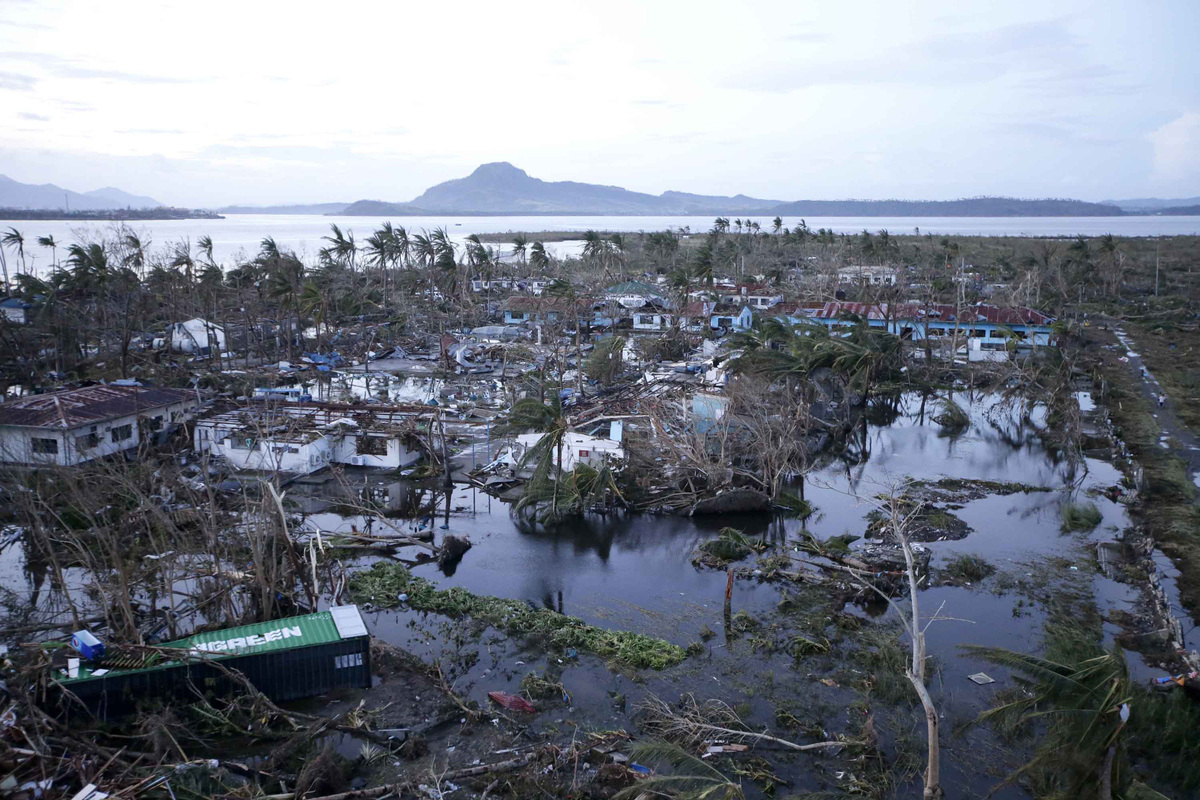
HOW TO YOU PREPARE FOR THIS?
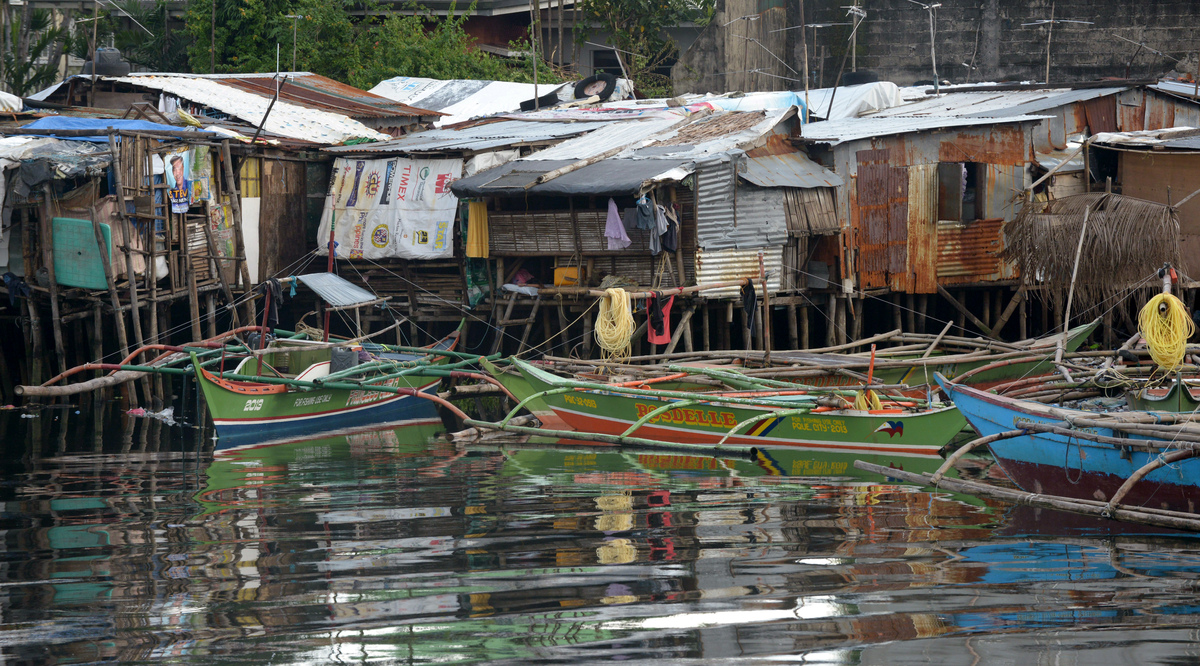
WHY WOULD YOU LIVE IN A PLACE LIKE THIS?
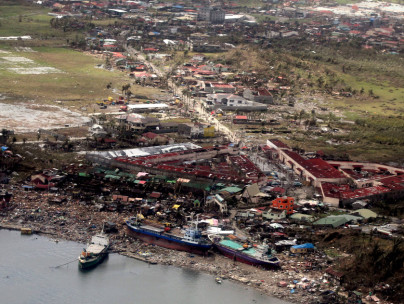
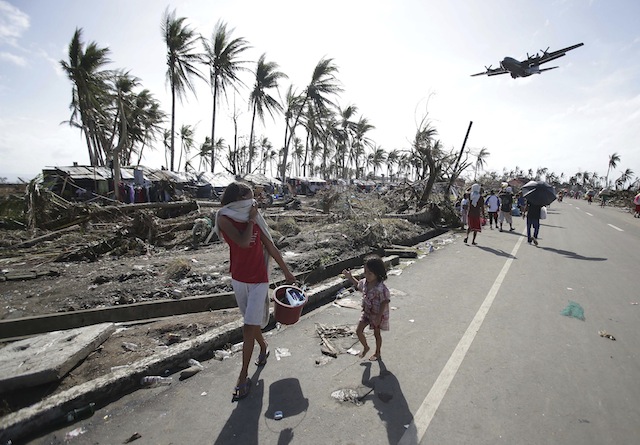
SURVIVORS
PREVIOUS TYPHOONS
-
www.greatdreams.com/weather/hurricane_2001.htm - Similarto
THE HURRICANE / TYPHOON SEASON
OF 2001/2002
A Prophecy? 9-10-2001. I was dreaming that I was in a huge room, with
the ceiling about 50 feet above the floor ... not a normal house. I was
told by someone off ...
-
www.greatdreams.com/weather/hurricanes-2008-b.htm
Typhoon "Fung
Wong" intensifies and moves toward Philippine islands 7-27-08 14 dead.Typhoon Kalmaegi
death toll rises to 16 in Taiwan - 7-19-08. Typhoon ...
-
www.greatdreams.com/japan_database.htm - Similarto
JAPAN DATABASE - Dreams of the Great Earth Changes
By early afternoon, the typhoon,
Japan's 15th of the season, ... It was expected to hit coastal areas of
central and eastern Japan late Monday or early .
-
www.greatdreams.com/blog-2013-3/dee-blog579.html
Oct 16, 2013 ... TOKYO
(Reuters) - A typhoon killed
17 people in Japan on Wednesday, most on an offshore island, but largely
spared the capital and caused .
-
www.greatdreams.com/weather/winter_records-2004.htm - Similarto
WINTER RECORDS - Dreams of the Great Earth Changes
Also not noted here have been these past year's worldwide record numbers
of floods, tornados, hurricanes, cyclones and typhoons that
have served to make this ...
-
www.greatdreams.com/weather/weather_manipulation.htm - Similarto
WEATHER MANIPULATION and THE RESULTS
Aug 29, 2005 ... For
example a cyclone can be created by these methods but the challenge lies
in guiding the cyclone or typhoon to
the adversary's ...
-
www.greatdreams.com/ships/ship-deaths.htm - Similarto
THE GREATEST SHIP COLLISION IN MARITIME HISTORY
10 dead from Typhoon Frank
- 6-19-08 6 dead - 3 missing - China Sea - 5-27-08 6 dead - Sydney
Harbour - 5-1-08 19 missing -presumed dead - Hong Kong ...
-
www.greatdreams.com/weather/hurricanes_for_2006.htm - Similarto
2006 Hurricanes and other Storms around the World
May 20, 2006 ... The typhoon raged
across the South China Sea this past week, then weakened into a tropical
storm and lost strength Saturday off southern ...
-
www.greatdreams.com/haarp-sun.htm - Similarto
HAARP VS THE SUN - Dreams of the Great Earth Changes
On Saturday - the day when there were 0 sunspots - the dark forces of
the Universe tried to force the tuning to occur and failed. They were
unable to do it.
-
www.greatdreams.com/political/exercises.htm - Similarto
NORTHCOM Plans 5 Day Martial Law Exercise
"In the early morning of 27 August 2008, Typhoon "X"
with a velocity of 140 ... Thetyphoon caused
heavy damage to houses, public buildings and facilities, ...
-
www.greatdreams.com/weather/tsunami_in_our_future.htm - Similarto
TSUNAMI IN OUR FUTURE - Dreams of the Great Earth Changes
Tokyo (VNA) - The number of deaths caused by typhoon Tokage,
which hit Japan's Canto island area on Wednesday, had risen to 62 by
Thursday afternoon , ...
-
www.greatdreams.com/weather-deaths.htm - Similarto
WEATHER DEATHS - 2004 - Dreams of the Great Earth Changes
May 25, 2004 ... CNN.com
- 18 dead after typhoon hits
Japan - Sep 30, 2004 ... The nine new ... edition.cnn.com/2004/WORLD/asiapcf/09/30/japan.typhoon/.
-
www.greatdreams.com/isadore.htm - Similarto
HURRICANE ISIDORE - Dreams of the Great Earth Changes
Sep 30, 2002 ... THE
HURRICANE/TYPHOON SEASON OF 2001
· WEATHER ANOMALIES · U.S. CONCENTRATION CAMPS - FEMA · NATIONAL ...
-
www.greatdreams.com/blog-2012-2/dee-blog278.html - Similarto
Dee Finney's blog August 25,2012 page 278 Hassidic Jews vs ...
Aug 25, 2012 ... Philippine Typhoon News
- Tropical Storm “Quiel” (international codename: ... '
Super Typhoon' on Track to
Deluge Hong Kong | TIME.com.
-
www.greatdreams.com/weather/hurricanes-2007.htm
On Thursday, the storm had sustained winds of 41 mph, less than half its
strength of 95 mph just 24 hours earlier, the Joint Typhoon Warning
Center said.
-
www.greatdreams.com/chgnews.htm - Similarto
LATEST EARTHCHANGES NEWS -
9-10-2001 - HURRICANE/TYPHOON SEASON
2001. 9-9-2001 - EARTHQUAKE IN HOLLYWOOD, CA. 8-14-2001 - OIL PIPELINES
TO EXPAND GWB ISN'T ...
-
www.greatdreams.com/weather/weather_extremes.htm
The BBC's Sarah Toms in Manila says the area lies in the path of several typhoons each
year, and that coconut trees common locally have shallow roots which ...
-
www.greatdreams.com/weather/hurricanes.htm - Similarto
HURRICANES
Sep 20, 2003 ... compiled
by Dee Finney. HURRICANE / TYPHOON SEASON
OF 2001 · HURRICANE ISIDORE AND OTHER HISTORICAL HURRICANES.
-
www.greatdreams.com/weather/massive_floods_in_history.htm - Similarto
MASSIVE FLOODS IN HISTORY - Dreams of the Great Earth Changes
HURRICANES / TYPHOONS /
CYCLONES First typhoon in
2005 emerges in Pacific
<http://www.tass.ru/eng/level2.html?NewsID=1647477&PageNum=0>
-
www.greatdreams.com/blog-2012-3/dee-blog378.html - Similarto
Dee Finney's blog November 17, 2012 page 378 10 SHOCK ...
Nov 17, 2012... rather most
of the remaining earthquakes that I researched on that day had been
preceded by the landfall of a major hurricane or typhoon.
-
www.greatdreams.com/samoa.htm - Similarto
EARTHQUAKE AND TSUNAMI - ISLANDS
Sep 29, 2009... of the
Indonesia archipelago, the risks from earthquakes and typhoons ...the
Philippines, which is still mopping up from a typhoon that
killed ...
-
www.greatdreams.com/superstorm.htm - Similarto
THE COMING GLOBAL SUPERSTORM
Feb 10, 2004 ... THE
HURRICANE / TYPHOON SEASON
OF 2001/2002 ... Whipping up violent waves and battering a wide swathe
of the main island Honshu, ...
-
www.greatdreams.com/meteor-showers.htm - Similarto
cosmic dust cloud - incoming - Dreams of the Great Earth Changes
Jul 6, 2004 ... "coastal
patrol ships Typhoon and
Sirocco prepared to leave port at the Little Creek Naval Amphibious Base
Friday to relieve two sister ships" ...
-
www.greatdreams.com/weather/weather_anomalies.htm - Similarto
WEATHER ANOMALIES - Dreams of the Great Earth Changes
HURRICANES. compiled by Dee Finney. HURRICANE / TYPHOON SEASON
OF 2001. HURRICANE ISIDORE AND OTHER HISTORICAL HURRICANES .
-
www.greatdreams.com/disaster-dreams2.htm - Similarto
DISASTER DREAMS PAGE 2 - Dreams of the Great Earth Changes
A typhoon was
going on with winds of 106 km per hour. *************************** *.
1-20-01 - DREAM - I was looking at some charts about earthquakes.
-
www.greatdreams.com/floods_2002.htm - Similarto
FLOODS 2002 - Dreams of the Great Earth Changes
Jul 5, 2002 ... The
storm is the remnant of Typhoon Rammasun,
which was downgraded to a severe tropical storm Friday after bringing
bad weather to China, ...
-
www.greatdreams.com/revblack.htm - Similarto
REVELATION OF THE TRUE SATAN
INTRODUCTION. These dreams are presented exactly as written in my
journals. At the time I had these dreams, I had not studied any of the
scholarly works ...
-
www.greatdreams.com/52planes.htm - Similarto
DREAMS OF PLANES CRASHING AND MILITARY GOGGLES
May 21, 2000 ... OSLO,
May 12, 2000 (Reuters) - Norway said on Friday it would scrap a plan to
buy 20 fighters in a contest pitting the Eurofighter Typhoon ...
-
www.greatdreams.com/blog-2013-2/dee-blog537.html
Jul 25, 2013 ... We
saw widespread flooding in Nepal, Pakistan, Russia, Romania, North
Korea, Nigeria, the UK, Spain, a typhoon in
the Philippines and ...
-
www.greatdreams.com/weather/floods-2007.htm - Similarto
FLOODS - 2007
China's typhoon season
is just getting under way in the south. Experts last month warned that
the Yangtze could flood badly this year for the first time since
1998 ...
-
www.greatdreams.com/winter-2003.htm - Similarto
THE WINTER OF 2002/2003 - Dreams of the Great Earth Changes
Feb 17, 2003 ... HURRICANE/TYPHOON SEASON
OF 2001/2002 · THE ARKANSAS ICE STORM - DECEMBER 2000 · THE INCREDIBLE
SHRINKING OZONE ...
-
www.greatdreams.com/flood_database.htm - Similarto
FLOOD DATABASE - Dreams of the Great Earth Changes
THE FLOOD - AN END TIME PROPHECY The Flood did not ...
-
www.greatdreams.com/tailhook.htm - Similarto
TAILHOOK - BOTH SIDES - Dreams of the Great Earth Changes
Once he was beached by the swirling currents of Typhoon Tailhook,
Kelso should have had the courage to defend his ship against those who
stormed aboard, ...
-
www.greatdreams.com/blog-2012-2/dee-blog216.html
May 8, 2012... and four Typhoon fighter
aircraft based at RAF Northolt in west London. The show of force is
designed to test the responsiveness of antiterror ...
-
www.greatdreams.com/winter_2001.htm - Similarto
WATER, WATER, EVERYWHERE - WINTER OF 2001-2002
Earlier this month, tropical storm Lingling killed more than 184 people
in the southern Philippines before gaining typhoon force
and heading to central Vietnam, ...
-
www.greatdreams.com/japan_quake_2007.htm - Similarto
DEADLY JAPAN QUAKE - Dreams of the Great Earth Changes
Jul 16, 2007 ... Company
Says Radioactive Leak Was Bigger · Problems at Japan's Quake-Hit Reactor
· Japan Nuclear Accidents Glance · Typhoon Misses ...
-
www.greatdreams.com/blog-2012-2/dee-blog259.html - Similarto
Dee Finney's blog July 29, 2012 page 259 EVENTS OF 1978
Jul 29, 2012 ... 1978
Pacific hurricane season (4 P). 1 cont. ▻ 1978 Pacific typhoonseason
(1 P) . E. ▻ 1978 earthquakes (3 P). F. ▻ 1978 floods (1 P). T.
